
The Sega Master System might not be the instantly recognisable icon that its main competitor, the Nintendo Entertainment System is, but it served as the introduction to video games for many players in the UK, continental Europe, Australia and Brazil. Mentioning Alex Kidd (or its malapropism, “Alex the Kid”) to anyone from one of these countries is likely to illicit the same nostalgic flash as Super Mario Bros. would from an American or Japanese fan.
For those of you who are just starting out collecting games, or missed the Master System the first time around, this feature will tell you everything you need to know about the Master System.
Key Facts
- First released in Japan on October 20, 1985 as the Sega Mark III.
- Released in North America in June 1986
- Released in Europe and Australia in September 1987.
- Released in Brazil in September 1989
- #1 best-selling game: Alex Kidd in Miracle World (1986)
- 13 million units sold worldwide
- Discontinued in North America in 1992, but not until 1996 in Europe and Australia.
- Last standard release of the console with a cartridge slot was in 2003 in Brazil, while the last TecToy game was published in 1998.
- System was re-released as recently as 2010 with built-in games.
|
—
Significance
The Master System is responsible for introducing affordable video game entertainment to the masses in parts of Europe, Australia and Brazil. It helped to create competition and choice in the marketplace for the third generation.
Sega was a big name in the arcade scene in the 80s, and used this to their advantage when creating software for the Master System. Big name arcade titles like Hang-On, Space Harrier, Wonder Boy and Shinobi were key releases for the system in its early years. Sega established key home console franchises on the Master System, including Phantasy Star and Alex Kidd.
Not all of Sega’s hits were original – the company struck a lucrative deal with Disney in the early 90s which led to some fantastic games like Castle of Illusion Starring Mickey Mouse and The Lucky Dime Caper Starring Donald Duck. Sega also licensed the popular French comic Asterix, which led to a few quality titles.
While Nintendo’s restrictive licensing agreements saw them tie up the majority of the third party video game developers’ services, Sega figured out ways around the contracts by licensing these games from other developers and reprogramming them for the Master System in-house or through contractors. This way, Master System owners didn’t miss out on games such as Double Dragon, Ninja Gaiden and Ghouls ‘n’ Ghosts.
With the success of the Master System in Europe, several home computer developers and established publishers gave the system plenty of attention. Acclaim Entertainment, Domark and US Gold were particularly prolific, bringing titles such as Speedball, Xenon II and Mortal Kombat to the system.
Did You Know?
- The Sega Mark III was the successor to the SG-1000, a console version of the SC-3000.
- Mark III is fully backwards compatible with the SG-1000
- The Sega Mega Drive is technically fully backwards compatible with the Master System, you just need the pass through device, the Power Base Converter, to make the cartridges fit.
- Tonka was the distributor of the Sega Master System in America for several years
- Certain configurations of the Master System came with built-in games that weren’t Alex Kidd in Miracle World
- Mega Drive controllers work on the Master System. The B button becomes the 1 Button and the C button becomes the 2 button.
- US and PAL games are not region locked.
- The rarest game on the system is The Smurfs 2: Smurfs Travel the World, which happens to be the final verified release in Europe.
- Sanritsu and SIMS are responsible for many of the games incorrectly attributed to Sega.
|
—
Market Success
Sega experienced variable success with the Master System. The Mark III experienced success initially, selling 1 million units in the first year. However the system’s fate was pre-determined as it launched head on into a post-Super Mario Bros. pandemic in Japan. The mild success experienced by exclusive titles such as Phantasy Star and Akai Koudan Zillion led Sega to keep the system on life support. They attempted to rebrand the Mark III in 1987 using the Master System moniker used in the rest of the world, but the Famicom was just too strong. The system was discontinued in Japan in 1989 after the release of Bomber Raid.
The situation was not too dissimilar in America. While the Master System launched around the time the NES went into wide release, Nintendo’s restrictive deals with publishers and retailers led to a distinct lack of store frontage and software. Sega attempted to revitalise the Master System by licensing publishing and distribution to toy company Tonka, but they were clearly inexperienced, choosing to distribute poor quality titles in high numbers, while leaving notable games like Psycho Fox out in the cold. Sega ended the deal with Tonka after the successful launch of the Genesis in order to wring the last drops of life out of the console before quietly discontinuing it in 1992 after the Genesis hit its stride.
Greater success was found in Europe, where Sega initially teamed up with Mastertronic for distribution and marketing of the system. With audiences relatively indifferent to the NES, Virgin priced the Master System and its software aggressively, and sought software support from a variety of European developers, who were familiar with the system’s Zilog Z80 architecture. While the system was not quite as popular as the personal computers which dominated Europe, the Master System’s success in Europe made Sega take notice and begin distributing the system their self. With the release of the budget priced Sega Master System II in 1990, the Master System became the dominant console force through Europe until it was overtaken by its successor, the Mega Drive. The system was still popular enough to maintain a steady flow of releases until 1996.
Australians quickly fell in love with the Sega Master System when it was launched in 1987, and like Europe, the system exploded following the release of the budget priced Sega Master System II. Ozisoft, later Sega Ozisoft, adopted a similar approach to Mastertronic in that it aggressively priced the system’s hardware and software, with Master System titles available from $AU19.95 to $AU59.95 – as low as a quarter of the price of NES software. Sega Ozisoft continuously ran roadshows for the system, promoted with ads on television and through home video, and even launched their own membership program, Sega Club. The system’s success endured through to the mid 90s, with Ozisoft pulling the plug in 1995 in preparation for the launch of the Saturn.
Brazil proved to be the strongest and most enduring market for the Master System. Tec Toy, Sega’s Brazilian distributor found success through affordable pricing and a variety of original software specifically designed to suit Brazilian tastes. They even translated games like Phantasy Star into Portugese. When Sega pulled the plug on the Master System in Australia and Europe in 1995-1996, the market in Brazil was still strong, leading Tec Toy to start producing their own games, mostly based on Game Gear titles. Brazilian exclusives include games such as Sonic Blast, Mortal Kombat 3 and Street Fighter II. Tec Toy continues to sell variants of the Master System in Brazil to this day, albeit with a pre-configured selection of games and no cartridge slot.
The Master System was also released in South Korea by Samsung under license from Sega, due to rules regarding Japanese exports. The system was marketed as the Samsung Gam*Boy, with a name change to the Samsung Aladdin Boy when the final model of the system was released.
Collecting for the Master System
So you’ve decided you want to collect games for the Sega Master System – good for you! You’re in for a lot of fun, and it’s a whole lot less stressful (and much cheaper) than collecting for the NES. In fact, we’ve assembled a list of the pros and cons of collecting for the system below.
| Advantages |
Drawbacks |
- The games and hardware are cheap
- The hardware is more powerful than the NES
- Hard clamshell cases are durable
- The best games are easy to find
- Some ports are superior to other systems
- Reliable hardware
|
- Tons of genuinely awful games
- The pause button is on the console
- Poor quality, non-colour manuals
- Non-standardised packaging for Australian releases – the same game could come in as many as four configurations
- Majority of post 1991 games designed for PAL systems, causing issues on NTSC systems
|
—
The Games
The Master System might only have half as many games as the other major formats, but you really still should consider only sticking to the good stuff. We’ve assembled the following guides to help you find the best titles for your Master System library
The Essential Sega Master System Games (coming soon)
The Underrated Sega Master System Games (coming soon)
The Rare and/or Expensive Sega Master System Games (coming soon)
Collecting for the Sega Master System on a budget (coming soon)
The Best Imports on the Sega Master System (coming soon)
Media
Sega Master System games can be found on three different kinds of media – the standard cartridge, the Mark III cartridge, and the Sega Card.
 |
Master System Cartridges
The standard Sega Master System cartridge is a small rectangular unit made from black plastic with 50 pins and a red label (some exceptions apply). There is no regional lockout between American, European, Australian and Brazilian cartridges, though the vast majority of games developed from 1990 onwards are intended for play at 50Hz. |
 |
Mark III cartridges
Cartridges used in the Japanese and Korean systems are quite different to the carts we’re familiar with. These carts are taller and narrower, with only 44 pins, making them incompatible with the western Master System units. The cartridges have the same shape and pin configuration as the earlier SG-1000.
|
 |
Sega Cards
Sega Cards, or Sega My Cards, are a credit card sized media format intended to be an alternative to cartridges for games of smaller ROM sizes. Cards were originally introduced in Japan with the SG-1000 II, so Japanese cards are marked as Mark III cards to differentiate them. Due to the small capacity of the cards, they were dropped from the redesigned Sega Master System II. |
—
|
Oh Ozisoft, What have you done?
Sega Ozisoft was notorious for slashing costs with little regard for the end-user experience. As such, games from Australia tend to be noticeably cheaper to those from the rest of the worlds. The plastic cases are not of a uniform size, being slightly smaller and thinner than UK cases. Some come in an easily crushable soft plastic case. Labels were made from low quality paper stock with inferior glue.
Of course with Ozisoft, nothing was ever uniform, so you can find multiple versions of the same game with slight differences.
Ozisoft releases can be easy to distinguish based on a few telltale signs. First, the cartridges may have “Made in Australia” on the back. Secondly, the red cartridge label will have white lines instead of black lines. Some cartridges may even have a blue label with the Sega Hotline phone number, or a white background with red text. A small number of games use silver coloured plastic for the clamshell case and cartridge enclosure. |
—
Hardware
There were a number of different Sega Master System configurations available, which varied greatly based on the region you were in.
 |
Sega Mark III
The original Japanese release of the console features quite a nice design. It’s a little different from the Master System internally, since you can add in an FM sound adaptor, and it also plays SG-1000 and SG-1000 II games. Not entirely difficult to find out in the wild. |
 |
Sega Master System (Japan)
Sega decided to try and rebrand the Mark III in Japan in 1987, releasing a new version of the system under the Master System name. Thought it looks identical to the Western Master System, it has a Japanese style cartridge slot and the FM Sound Unit is built-in. |
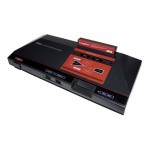 |
Sega Master System (World)
The original release of the Master System is a futuristic looking beast which supports just about everything you can throw at it like the 3D glasses and card games (though it won’t support the JP only FM add-on or SG-1000 games). It’s quite a robust system – reliable and solidly built with better picture and sound quality than the models that followed. It also has support for monoaural AV output. |
 |
Power Base Converter/Master System Converter/Mega Adaptor
The Mega Drive is backwards compatible with the Sega Master System at the hardware level – the Zilog Z80 which powered the Master System serves as the Mega Drive’s sound chip. Of course, you simply can’t plug your SMS carts into your Mega Drive – you need the Power Base Converter. While it looks like a complex peripheral, there’s actually very little going on in there – it just connects to a pin on the Mega Drive cartridge slot which tells the system to boot in Master System mode. It is, however, compatible with card games and the 3-D Glasses. |
 |
Master System Converter II
While it technically works, the Master System Converter doesn’t really fit the Mega Drive II without the removal of the outer casing. Sega of Europe commissioned the Master System Converter II, which is shaped more like a simple cartridge – though it doesn’t support card games or the 3-D Glasses. Was only released in Europe where the Master System was still active. |
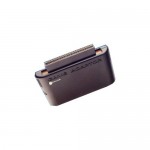 |
Master Mega Converter
The Master Mega Converter is an unlicensed clone of the Master System Converter II released by Australian company Home Entertainment Suppliers around the time of the release of the Mega Drive II. |
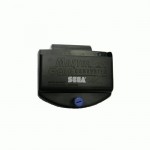 |
Master Gear Converter
To put it in a very simplistic way, the Game Gear is basically a shrunken version of the Master System, but the game cartridges are different. For those who didn’t want to rebuy all of their Master System games, Sega released the Master Gear Converter, another pass through device that let you play any Master System game on the Game Gear. Games have a tendency to run a bit faster through the Master Gear, though. |
 |
Sega Master System II (Grey)
After the Master System began to take hold in Europe, Sega decided to create a new model that could capture more budget minded consumers. The Master System II drops a few of the finer features of the original console like AV Out, card game support and 3-D Glasses support, but it’s still a sturdy piece of work that gets the job done. Gotta love that retractable cartridge door, too. The original Master System II models are grey with a white pause button. |
 |
Sega Master System II (Black)
Functionally identical to the original Master System II, these later models were black with a black pause button. |
 |
Samsung Gam*Boy
Due to diplomatic tensions between Japan and South Korea, Japanese companies tended to not be able to sell merchandise directly in South Korea. The solution to this was to partner up with Korean companies and license the systems. Sega teamed up with Samsung for the Master System, which was released as the Gam*Boy. It’s based on the Japanese version of the Master System, but has unique controllers. A revised version was made available after the release of the Super Gam*Boy (Mega Drive), though the only change was the logo. |
 |
Samsung Gam*Boy II
The Gam*Boy II is an interesting beast – it’s based on the Master System II, but has a Japanese style cartridge slot. It also features a different grey/blue colour scheme, not seen on any other Master System II variants. Another variant was issued when Samsung redesigned their logo, but its entirely superficial. |
 |
Aladdin Boy
For reasons unknonw, Samsung decided to rebrand the Gam*Boy range as the Aladdin Boy in 1993 – probably something to do with the release of Disney’s Aladdin. Again, the difference is mostly superficial with different logos, but for some bizarre reason, it shipped with three button Mega Drive pads instead of the old Gam*Boy pads. |
 |
Sega Master System III Compact
The Master System III line is functionally identical to the Master System II the rest of the world got, but there’s a different colour motif, and the console came with six button Mega Drive style pads. Later versions of the system came with gradually increasing number of built-in games. |
 |
Tectoy Master System Super Compact
The Master System Super Compact is a small, almost-portable Master System designed by TecToy. It’s basically a handheld Master System that has its own aerial, which sends a signal that can be picked up by a nearby TV. Of course the aerial connection is prone to interference, so it comes with AV cables too. The control pad fuctionality can be used either directly through the inputs on the system, or by connecting regular Master System pads. |
 |
Sega Master System Girl
The Master System Girl is virtually identical to the Super Compact, but has a colour scheme and built-in games designed to appeal to girlish tastes. |
 |
Sega Master System III Collection
The Master System III Collection series was a line of TecToy consoles with an increasing number of built-in games. The number of built-in games was usually exaggerated by the inclusion of the compilation game 20 em 1. The Master System III Collection 131 was the final TecToy model to have a standard cartridge slot. Like other later TecToy machines, they all came with 6 button pads for no real reason. |
 |
Master System Kiosk
A store display unit for showing off multiple Master System games, the Kiosk actually uses different hardware to the standard Master System. The Kiosk has sixteen cartridge slots and four controller ports. It’s designed to sit on top of a TV. A standard kiosk shipped with sixteen games (Alex Kidd in Miracle World, Choplifter, Enduro Racer, Fantasy Zone II, Gangster Town, Ghostbusters, Great Baseball, Great Basketball, Great Football, Great Golf, OutRun, Penguin Land, Rambo, Rocky, Space Harrier, and Zillion), each with their own selection card. |
 |
Sega Game Box 9
The Game Boy 9 is a coin-operated system which allowed guests to select from 9 different Mark III games to play. It was similar to the Kiosk system, albeit for use in hotels. |
 |
Tectoy Master System 3
After the end of the Master System Collection line, Tectoy dropped the cartridge slot and started to focus on system-on-a-chip models of the Master System, increasing the number of built-in games. Another version, the Master System Evolution was released in 2011 which contains many of the same games, but features a different outer case. |
 |
Tectoy Master System Handy
Another system-on-a-chip from Tectoy, but all of the games were built directly into a controller rather than using a standard console setup. Of course, 20 of the 27 games are from 20 em 1 again. |
—
|
Checkered Squares
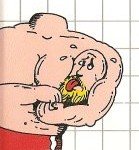 Master System games have become quite notorious over the years for featuring some pretty bad box art. Most of it is merely bland due to the use of the white checkered square motif on most games, but it can get quite bizarre, like Pro Wrestling’s use of a guy giving himself a headlock. Later Master System games began to veer away from the standard motif, and the box art improved dramatically. Master System games have become quite notorious over the years for featuring some pretty bad box art. Most of it is merely bland due to the use of the white checkered square motif on most games, but it can get quite bizarre, like Pro Wrestling’s use of a guy giving himself a headlock. Later Master System games began to veer away from the standard motif, and the box art improved dramatically.
|
—
Bundles
One of the keys to Sega’s success with the Master System in later years was bundling the system in a variety of combinations. We’ve tried to track down as many of the different packages from across the world as we can.
 |
Mark III
|
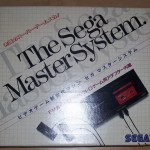 |
Master System (Japan)
- System
- 2x controllers
- FM Sound Unit (built in)
|
 |
The Sega Base System (USA)
Revised version with new style controllers was available |
 |
The Sega Master System (USA)
- System
- 2x controllers
- Light Phaser
- Hang-On/Safari Hunt multi-cart
Re-released with new style controllers |
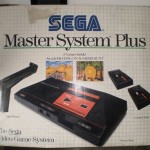 |
The Sega Master System Plus (USA)
- System
- 2x controllers
- Light Phaser
- Hang-On/Safari Hunt (built-in)
Identical to the Master System pack, just with Plus on the box and the games built in. |
 |
The Sega Video Game System (USA)
- System
- 2x controllers
- Light Phaser
- 3-D Glasses
- Missile Defense 3-D
This was the first system marketed by Tonka in the US. |
 |
Sega Base System (USA)
- System
- 2x controllers
- Hang-On (built-in)
Tonka reintroduced the Sega Base System when it decided to market multiple bundles. |
 |
Sega Master System (USA)
- System
- 2x controllers
- Light Phaser
- Hang-On/Safari Hunt (built-in)
Tonka re-issued version, with built-in games instead of a cartridge |
 |
SegaScope 3-D System (USA)
- System
- 2x controllers
- Light Phaser
- 3-D Glasses
- Missile Defense 3-D
Basically a rebranded version of the Sega Video Game System. |
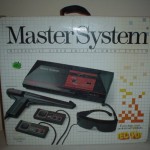 |
Master System (Brazil)
- System
- 2x controllers
- Hang-On/Safari Hunt (built-in)
Despite the pictures on the packaging, no Light Phaser or 3-D Glasses are included |
 |
Master System 3D (Brazil)
- System
- 2x controllers
- Hang-On/Safari Hunt (built-in)
- Missile Defense 3-D
Despite the 3D name in the console and pictures all over the box and inclusion of a 3D game in the pack, it doesn’t actually include the 3-D Glasses |
 |
Master System II (Brazil)
- System
- 1x controller
- Alex Kidd in Miracle World (built-in)
TecToy brought out its own “Master System II” which was basically just the original Master System with a different logo, hence why the Master System II is the Master System III there. |
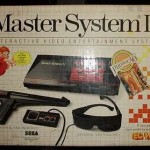 |
Master System II w/ Jogos de Verao (Brazil)
- System
- 1x controller
- Alex Kidd in Miracle World (built-in)
- Jogos de Verao (California Games)
|
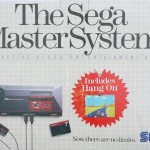 |
The Sega Master System (Europe)
- System
- 2x controllers
- Hang-On
|
 |
Sega Master System (Europe, Australia)
- System
- 2x controllers
- Alex Kidd in Miracle World (built-in)
|
 |
Sega Master System Plus (Europe, Australia)
- System
- 2x controllers
- Light Phaser
- Hang-On/Safari Hunt (built-in)
|
 |
Sega Super System (Europe)
- System
- 2x controllers
- Light Phaser
- 3-D Glasses
- Missile Defense 3-D (built-in)
|
 |
Sega Master System Plus Special Edition (UK)
- System
- 2x controllers
- Light Phaser
- Hang-On/Safari Hunt (built-in)
- Michael Jackson’s Moonwalker
|
 |
Sega Master System II (Europe, Australia, USA)
- System
- 1x controller
- Alex Kidd in Miracle World (built-in)
Both Grey and Black models available |
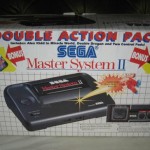 |
Sega Master System II Double Action Pack (Europe, Australia)
- System
- 2x controllers
- Alex Kidd in Miracle World (built-in)
- Double Dragon
|
 |
Sega Master System II w/ Sonic the Hedgehog (Europe, Australia)
- System
- 1x controller
- Alex Kidd in Miracle World (built-in)
- Sonic the Hedgehog
These bundles come in a few different varieties – most are simply a sticker slapped on the front, some have an extra controller, while the French one is a printed box |
 |
Sega Master System II w/ Shinobi
- System
- 1x controller
- Alex Kidd in Miracle World (built-in)
- Shinobi
|
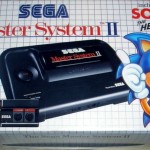 |
Sega Master System II w/ Sonic the Hedgehog (Europe, Australia)
- System
- 1x controller
- Sonic the Hedgehog (built-in)
Sonic the Hedgehog was used alongside Alex Kidd in Miracle World for the main built-in game from 1991 on. |
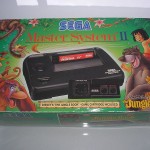 |
Sega Master System II w/ The Jungle Book (Europe)
- System
- 1x controller
- The Jungle Book
One of the few properly printed outer boxes for a bundle. Can’t confirm which built-in game these came with, though. Quite rare due to its release later in the system’s life. |
 |
Sega Master System II w/ Master Games I (Europe)
- System
- 1x controller
- Alex Kidd in Miracle World or Sonic the Hedgehog (built-in)
- Master Games I
This bundle came out after Sonic the Hedgehog became a built-in game, so it’s available in multiple configurations. |
 |
Sega Master System II Plus (Europe)
- System
- 1x controller
- Light Phaser
- Alex Kidd in Miracle World (built-in)
- Operation Wolf
A separate Italian release drops Operation Wolf despite keeping everything else. |
 |
Sega Master System II Plus X (Germany)
- System
- 2x controllers
- Alex Kidd in Miracle World (built-in)
- Sonic the Hedgehog
- Tennis Ace
|
 |
Sega Master System III Compact (Portgual)
- System
- 1x controller
- Sonic the Hedgehog (built-in)
Probably the rarest bundle going around, this was a kind of odd case of Sega’s Portugal arm importing stock from TecToy due to the language similarity. |
 |
Sega Master System III Compact (Brazil)
- System
- 1x controller
- Alex Kidd in Miracle World (built-in)
Due to the naming change, the Sega Master System II we know was released in Brazil as the Sega Master System III. This version comes in both blue and white boxes. |
 |
Sega Master System III Compact (Brazil)
- System
- 1x controller
- Sonic the Hedgehog (built-in)
|
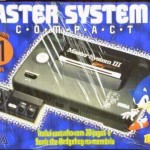 |
Sega Master System III Compact w/ 21 games (Brazil)
- System
- 1x controller
- Sonic the Hedgehog/20 em 1 (built in)
|
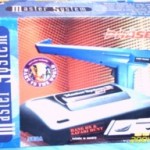 |
Sega Master System III (Brazil)
- System
- 1x controller
- Light Phaser
- Hang-On/Safari Hunt (built-in)
- The Simpsons: Bart vs. the World or Global Gladiators
This is quite a unique bundle. The Light Phaser is blue, and it’s the only Master System II model to have Hang-On/Safari Hunt and Snail Maze built-in. Despite the lack of “Compact” on the box, the system is still bearing the logo. |
 |
Sega Master System III Collection 74 (Brazil)
- System
- 2x 6 button controllers
- 74 built in games
|
 |
Sega Master System III Collection 105 (Brazil)
- System
- 2x 6 button controllers
- 105 built in games
|
| Image unavailable |
Sega Master System III Collection 112 (Brazil)
- System
- 2x 6 button controllers
- 112 built in games
|
 |
Sega Master System III Collection 120 (Brazil)
- System
- 2x 6 button controllers
- 120 built in games
|
 |
Sega Master System III Collection 131 (Brazil)
- System
- 2x 6 button controllers
- 131 built in games
|
—
|
3D Gaming
 The Master System touted 3D gaming capabilities thanks to the SegaScope 3-D Glasses peripheral. The glasses use LCD shutters that rapidly alternate opaqueness between the left and right lens. Combining this with the interlacing of video on CRT televisions creates a natural 3D effect – the left eye shows the top field, the right eye shows the bottom field. Despite heavy promotion from Sega, the glasses never really caught on, and they were doomed to obscurity by the Master System II’s loss of the card slot. The Master System touted 3D gaming capabilities thanks to the SegaScope 3-D Glasses peripheral. The glasses use LCD shutters that rapidly alternate opaqueness between the left and right lens. Combining this with the interlacing of video on CRT televisions creates a natural 3D effect – the left eye shows the top field, the right eye shows the bottom field. Despite heavy promotion from Sega, the glasses never really caught on, and they were doomed to obscurity by the Master System II’s loss of the card slot.
Eight 3D games are available for the system: Blade Eagle 3-D, Line of Fire, Maze Hunter 3-D, Missile Defense 3-D, OutRun 3-D, Poseidon Wars 3-D, Space Harrier 3-D and Zaxxon 3-D. The 3-D glasses and the games now tend to command a premium price due to high demand. |
—
Peripherals
A number of different controllers and other attachments were made available for the Master System by Sega and some other companies. Listed below is a chart containing every official peripheral we could find information on.
 |
Joypad
The Joypad is the basic controller for the Mark III. It’s modelled on the SG-1000 control pad, albeit with a more square directional pad. Has a removable thumbstick. |
 |
Master System Control Pad (original)
Modelled off the Mark III Joypad, the Control Pad is essentially the same thing with a different colour scheme. |
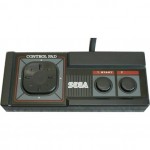 |
Master System Control Pad (revised)
Sega acknowledged that a cord coming out of the side of the controller is a damn hassle, so they moved it to the top. A second revision removed the thumbstick. |
 |
Super Gam*Boy Control Pad
The Samsung system ditches the square directional pad for a more Nintendo like cross. |
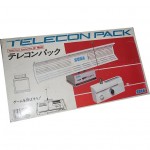 |
Mark III Telecon Pack
The Telecon pack eliminates the need for having a fixed cable connection to the TV by allowing your Mark III to transmit to your TV via RF signal. Not much use without a Japanese TV due to frequency differences. |
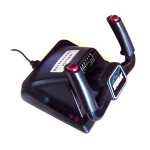 |
Handle Controller
The theory is that if you like driving games, you’ll want to play them with a steering wheel like device. The Handle Controller was meant to fulfill this desire, but it was notorious for its poor construction. Released by Hori in Japan, but picked up by Sega for release elsewhere. |
 |
The Sega 3-D Glasses
One of the most unique and sought after peripherals for the system, the 3-D Glasses utilise a shutter system to create the illusion of 3D imagery for compatible games. The shutter system allows for 3D games in full colour, but halves the frame rate of the games. |
 |
The Sega Control Stick
The Sega Control Stick promises to bring precision arcade style controls home. In reality, it’s rather clunky and that’s not helped by the stick being on the right and buttons on the left. Friendly for southpaws, though. |
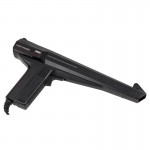 |
The Sega Light Phaser
The Light Phaser is a sleek, black light gun designed for a variety of shooting games. Due to its allegedly realistic appearance, modified versions were sold in America with red tips. The Light Phaser served as the basis for the design of JJ’s gun in the anime and game Akai Koudan Zillion. |
 |
Rapid Fire Unit
The Rapid Fire Unit is a small box which you can plug your controllers into that allows auto-repeat functionality – or turbo, as its more commonly known. Helps save your controllers, but is likely to have you branded as a filthy cheat. |
 |
The Sega Sports Pad
The Sports Pad is a trackball controller designed for use with a number of sports games (Great Ice Hockey, Sports Pad Football and Sports Pad Soccer). It allows for full 360 degree motion over your players, but can also be switched into traditional eight direction mode (though the Japanese version lacks this function). |
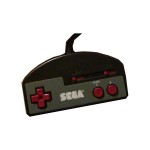 |
SG Commander
The SG Commander is another Hori product which Sega licensed outside of Japan. Basically combined the functionality of the standard Control Pad and the Rapid Fire unit, but uses a Nintendo style cross directional pad. |
 |
FM Sound Unit
The FM Sound Unit is an attachment for the Mark III which contains a Yamaha YM2413 chip, allowing for better sound quality on compatible games (of which there are roughly 40). It was built into the Japanese release of the Master System, but not released outside of Asia. |
 |
Paddle Control
Similar to an Atari style paddle controller, replacing the directional pad with a paddle. It also moves the placement of the buttons, with the 1 button larger and on the face of the controller while the 2 button is on the shoulder. The Paddle controller is required for use with most of the games that actually support it. |
 |
Action Replay
No system is complete without a cheat device made by Datel. The Action Replay lets you alter the code of the game you’re playing on the fly though the use of codes, to grant players infinite lives and such, or access debug menus hidden within the game code. |
 |
Floppy Drive
This unreleased peripheral planned to offer Master System games on traditional 3.5″ floppy disks. It is believed that Sega dropped plans to release the add-on due to the relatively high cost of 3.5″ floppy disks in the late 1980s and the general decline of the system outside of Europe at that point. |
—

















































































